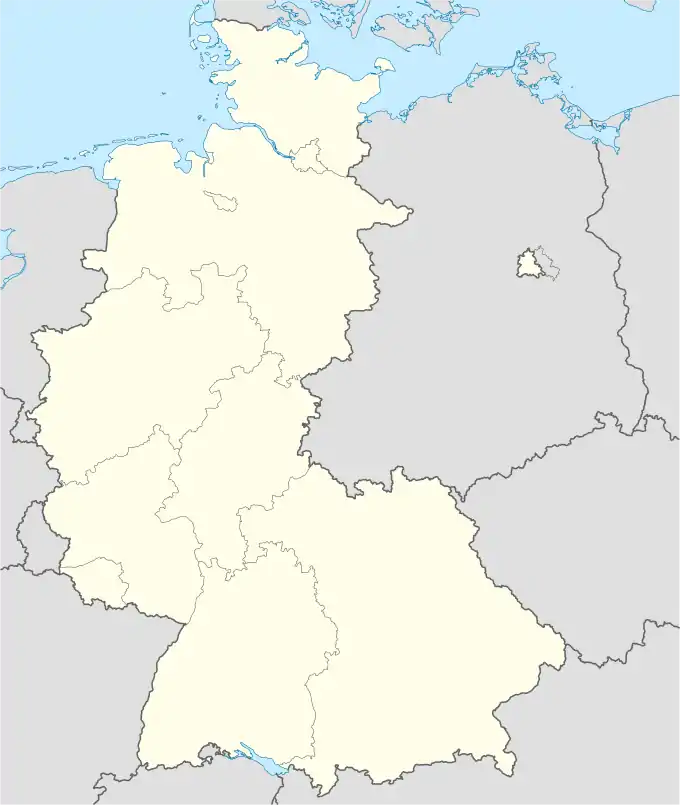1974 FIFA World Cup
The 1974 FIFA World Cup was the 10th FIFA World Cup, and was played in West Germany (including West Berlin) between 13 June and 7 July. The tournament marked the first time that the current trophy, the FIFA World Cup Trophy, created by the Italian sculptor Silvio Gazzaniga, was awarded. The previous trophy, the Jules Rimet Trophy, had been won for the third time by Brazil in 1970 and awarded permanently to the Brazilians. This was the first out of three World Cups to feature two rounds of group stages.
| Fußball-Weltmeisterschaft 1974 (German) | |
|---|---|
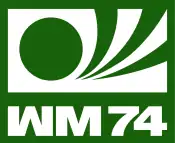 1974 FIFA World Cup official logo | |
| Tournament details | |
| Host country | West Germany |
| Dates | 13 June – 7 July |
| Teams | 16 (from 5 confederations) |
| Venue(s) | 9 (in 9 host cities) |
| Final positions | |
| Champions | |
| Runners-up | |
| Third place | |
| Fourth place | |
| Tournament statistics | |
| Matches played | 38 |
| Goals scored | 97 (2.55 per match) |
| Attendance | 1,865,762 (49,099 per match) |
| Top scorer(s) | |
| Best young player | |
| Fair play award | |
West Germany won the title, beating the Netherlands 2–1 in the final at the Olympiastadion in Munich. This was the second victory for West Germany, who had also won in 1954. Australia, East Germany, Haiti and Zaire made their first appearances at the final stage, with East Germany making their only appearance before Germany was reunified in 1990.
Host selection
West Germany was chosen as the host nation by FIFA in London, England on 6 July 1966. Hosting rights for the 1978 and 1982 tournaments were awarded at the same time. West Germany agreed a deal with Spain by which Spain would support West Germany for the 1974 tournament, and in return West Germany would allow Spain to bid for the 1982 World Cup unopposed.
Qualification
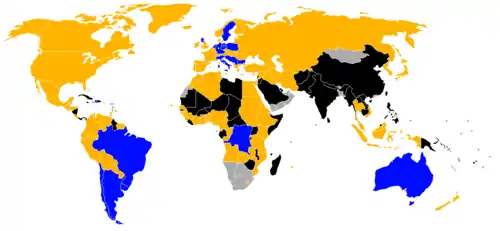
Ninety-eight countries took part in the qualifying tournament.
Some of football's most successful nations did not qualify, including 1966 champions England, France, hosts and quarter-finalists of the 1970 tournament Mexico, Spain, 1966 third-place finishers Portugal, 1970 quarter-finalists Peru, Belgium, Czechoslovakia, Hungary, and Romania. The USSR was also disqualified after refusing to travel for the second leg of their playoff against Chile as a result of the 1973 Chilean coup d'état. The Netherlands and Poland qualified for the first time since 1938. Scotland was back in the Finals after a 16-year absence. Argentina and Chile were also back after having missed the 1970 tournament and Yugoslavia was back after missing both the 1966 and 1970 tournaments.
First-time qualifiers were East Germany (who made their only World Cup or European Championship appearance as a separate team); Australia, which would not qualify again until the next time the tournament was held in Germany, in 2006; Haiti, the first team from the Caribbean to qualify since Cuba in 1938; and Zaire, the first team from sub-Saharan Africa to reach the finals.
As of 2018, this was the last time Haiti and Zaire (now DR Congo) qualified for a FIFA World Cup tournament, as well as the last time Spain failed to qualify.
This was the first tournament in which the defending champions (in this case Brazil) played in the opening game as opposed to the hosts, although this was later changed back to the hosts for the 2006 tournament, which was also held in Germany.
List of qualified teams
The following 16 teams qualified for the final tournament.
Format
The tournament featured a new format. While the competition once again began with the sixteen teams divided into four groups of four teams, the eight teams which advanced did not enter a knockout stage as in the previous five World Cups but instead played in a second group stage. The winners of the two groups in the second stage then played each other in the final, with the respective runners-up from each group meeting in the third place play-off. This was one of only two times that this format was deployed (1978 being the other); in 1982 a semi-final stage was introduced after the second group stage (expanded to four groups of three) before the World Cup revived the knockout stage in 1986 which is still used to the present day.
It was decided in advance that if the host nation progressed to the second stage their matches would not take place simultaneous to the other matches but instead be held in the other timeslot (either 16:00 or 19:30 local time).[2]
Summary

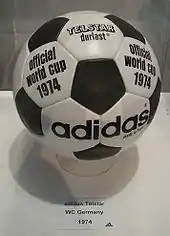
First round
The tournament was held mostly in bad weather, and the stadia had few protected places. Few western European nations had qualified, of which only The Netherlands, West Germany and Sweden made it past the Group Stage. Fans from the Eastern Communist neighbour states such as East Germany were hindered by political circumstances.
Carlos Caszely of Chile became the first player to be sent off with a red card in a World Cup match, during their match against West Germany. Red cards were formally introduced in World Cup play in 1970, but no players were sent off in that tournament.
Two teams made a particularly powerful impact on the first round. The Netherlands demonstrated the "Total football" techniques pioneered by the top Dutch club Ajax, in which specialised positions were virtually abolished for the outfield players, and individual players became defenders, midfielders or strikers as the situation required. The Dutch marked their first World Cup finals since 1938 by topping their first-round group, with wins over Uruguay and Bulgaria and a draw with Sweden. Sweden joined the Dutch in the second group round after beating Uruguay 3–0.
Poland, meanwhile, took maximum points from a group containing two of the favourites for the tournament. They beat Argentina 3–2, trounced Haiti 7–0, then beat Italy 2–1 – a result that knocked the Italians out of the Cup and resulted in Argentina qualifying for the second group round on goal difference. Argentina would not fail to win either of their opening two games of a World Cup again until 2018.[3] While Haiti didn't do particularly well in their first World Cup finals (losing all three of their games and finishing second to last) they did have one moment of glory. In their opening game against Italy, they managed to take the lead with a goal from Emmanuel Sanon, before eventually losing 3–1 (Italy had not conceded a goal in 12 international matches). That goal proved to be a significant goal as it ended Dino Zoff's run of 1142 minutes without conceding a goal.
Group 2 was a particularly close group. With Brazil, Yugoslavia and Scotland drawing all their games against each other, it was decided by the number of goals these three teams scored when defeating Zaire. Yugoslavia hammered the African nation 9–0, equalling a finals record for the largest margin of victory. Brazil beat them 3–0. Scotland however only managed a 2–0 margin, and so were edged out of the tournament on goal difference. They were the only team that did not lose a game in the tournament as well as becoming the first ever country to be eliminated from a World Cup Finals without having lost a match.
Group 1 contained both East Germany and the host West Germany, and they both progressed at the expense of Chile and newcomers Australia. The last game played in Group 1 was much anticipated, a first ever clash between the two German teams. West Germany was already assured of progression to the second round whatever the result. In one of the most politically charged matches of all time, it was the East that won, thanks to a late Jürgen Sparwasser goal. This result forced a realignment of the West German team that would later help them win the Cup.
Second round
Coincidentally, the two second-round groups both produced matches that were, in effect, semi-finals. In Group A, the Netherlands and Brazil met after each had taken maximum points from their previous two matches. In Group B, the same happened with West Germany and Poland – so the winners of these two games would contest the final.
In Group A, two goals from the inspirational Johan Cruyff helped the Dutch side thrash Argentina 4–0. At the same time, Brazil defeated East Germany 1–0. The Dutch triumphed over East Germany 2–0 while in the "Battle of the South Americans", Brazil managed to defeat Argentina 2–1 in a scrappy match. Argentina and East Germany drew 1–1 and were on their way home while the crucial match between the Netherlands and Brazil turned into another triumph for 'total football', as second-half goals from Johan Neeskens and Cruyff put the Netherlands in the final. However the match would also be remembered for harsh defending on both sides.
Meanwhile, in Group B, West Germany and Poland both managed to beat Yugoslavia and Sweden. The crucial game between the Germans and the Poles was goalless until the 76th minute, when Gerd Muller scored to send the hosts through 1–0. The Poles took third place after defeating Brazil 1–0.
Final
The final was held on 7 July 1974 at Olympiastadion, Munich. West Germany was led by Franz Beckenbauer, while the Dutch had their star Johan Cruyff, and their Total Football system which had dazzled the competition. With just a minute gone on the clock, following a solo run, Cruyff was brought down by Uli Hoeneß close to the German penalty area, and the Dutch took the lead from the ensuing penalty by Johan Neeskens before any German player had even touched the ball. West Germany struggled to recover, and in the 26th minute were awarded a penalty, after Bernd Hölzenbein fell within the Dutch area, causing English referee Jack Taylor to award another controversial penalty. Paul Breitner spontaneously decided to kick, and scored. These two penalties were the first in a World Cup final. West Germany now pushed, and in the 43rd minute, in his typical style, Gerd Müller scored what turned out to be the winning goal, and the last of his career as he retired from the national team. The second half saw chances for both sides, with Müller putting the ball in the net for a goal that was disallowed as offside. In the 85th, Hölzenbein was fouled again, but no penalty this time. Eventually, West Germany, European Champions of 1972, also won the 1974 World Cup.
This was the only case of the reigning European champions winning the World Cup, until Spain (champions of the UEFA Euro 2008) defeated the Netherlands in the South Africa 2010 FIFA World Cup Final. France have also held both trophies, albeit in a different order, at the same time by winning the 1998 World Cup followed by Euro 2000.
Joao Havelange (former FIFA President from 1974 to 1998) claimed that the 1966 and 1974 World Cups were fixed so that England and Germany would win respectively.[4]
This was only the second time that a team had won the World Cup after losing a match in the Finals (West Germany losing to East Germany during the group stage). The previous occasion was West Germany's earlier win in 1954.
Poland's Grzegorz Lato led the tournament in scoring seven goals. Gerd Müller's goal in the final was the 14th in his career of two World Cups, beating Just Fontaine's record of 13, in his single World Cup. Müller's record was only surpassed 32 years later, in 2006 by Ronaldo's 15 goals from three World Cups and then 8 years after, in 2014 by Klose's 16 goals from four World Cups.
Günter Netzer, who came on as a substitute for West Germany during the defeat by the East Germans, was playing for Real Madrid at the time: this was the first time that a World Cup winner had played for a club outside his home country.
This is the last of four FIFA World Cup tournaments to date with no extra-time matches. The others are the 1930, 1950, and 1962 tournaments.
Mascot
The official mascots of this World Cup were Tip and Tap, two boys wearing an outfit similar to West Germany's, with the letters WM (Weltmeisterschaft, World Cup) and number 74.
Venues
| West Berlin | Munich | Stuttgart |
|---|---|---|
| Olympiastadion | Olympiastadion | Neckarstadion |
| Capacity: 86,000 | Capacity: 77,573 | Capacity: 72,200 |
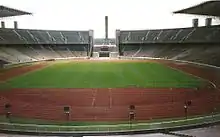 |
 |
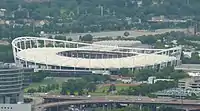 |
| Gelsenkirchen | ||
| Parkstadion | ||
| Capacity: 72,000 | ||
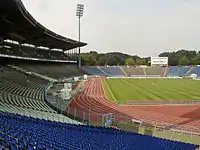 | ||
| Düsseldorf | ||
| Rheinstadion | ||
| Capacity: 70,100 | ||
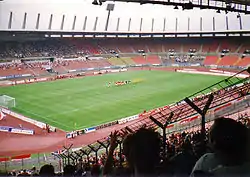 | ||
| Frankfurt | ||
| Waldstadion | ||
| Capacity: 62,200 | ||
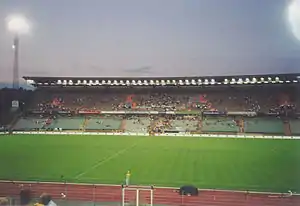 | ||
| Hamburg | Hanover | Dortmund |
| Volksparkstadion | Niedersachsenstadion | Westfalenstadion |
| Capacity: 61,300 | Capacity: 60,400 | Capacity: 53,600 |
 |
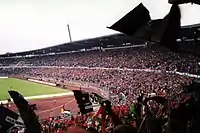 |
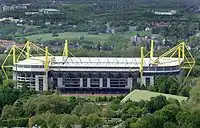 |
Match officials
AFC
CAF
CONCACAF
 Alfonso González Archundía
Alfonso González Archundía.svg.png.webp) Werner Winsemann
Werner Winsemann
CONMEBOL
 Ramón Barreto
Ramón Barreto Omar Delgado Gómez
Omar Delgado Gómez.svg.png.webp) Vicente Llobregat
Vicente Llobregat.svg.png.webp) Armando Marques
Armando Marques Luis Pestarino
Luis Pestarino.svg.png.webp) Edison Peréz Núñez
Edison Peréz Núñez
UEFA
 Heinz Aldinger
Heinz Aldinger Aurelio Angonese
Aurelio Angonese Doğan Babacan
Doğan Babacan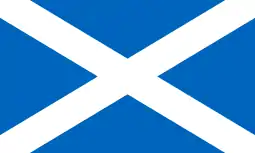 Bob Davidson
Bob Davidson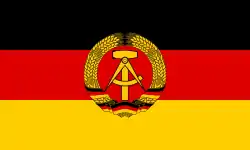 Rudi Glöckner
Rudi Glöckner Pavel Kasakov
Pavel Kasakov Erich Linemayr
Erich Linemayr.svg.png.webp) Vital Loraux
Vital Loraux Károly Palotai
Károly Palotai.svg.png.webp) Nicolae Rainea
Nicolae Rainea.svg.png.webp) Pablo Sánchez Ibáñez
Pablo Sánchez Ibáñez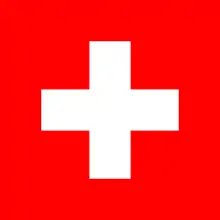 Rudolf Scheurer
Rudolf Scheurer Gerhard Schulenburg
Gerhard Schulenburg Jack Taylor
Jack Taylor.svg.png.webp) Clive Thomas
Clive Thomas Kurt Tschenscher
Kurt Tschenscher Arie van Gemert
Arie van Gemert Hans-Joachim Weyland
Hans-Joachim Weyland
OFC
Squads
For a list of all squads that appeared in the final tournament, see 1974 FIFA World Cup squads.
Seeding
It was agreed by a vote by the FIFA Organising Committee on who would be seeded.[5] The four seeds, who had been the final four teams of the previous tournament, were first placed in separate groups:
.svg.png.webp) Brazil (holders)
Brazil (holders) Italy
Italy Uruguay
Uruguay West Germany (hosts)
West Germany (hosts)
Then the remaining spots in the groups were determined by dividing the participants into pots based on geographical sections. When the final draw was held, the sixteenth and final qualifier was not yet known; it would be either Yugoslavia or Spain. These teams finished with an identical record in their qualification group and following this situation, rules were changed so that tied teams had to compete in a play-off game on neutral ground.
| Pot 1: Western European | Pot 2: Eastern European | Pot 3: South American | Pot 4: Rest of The World |
|---|---|---|---|
|
Final draw
The final draw took place on 5 January 1974 in Sendesaal des Hessischen Rundfunks in Frankfurt. The TV broadcast of this show was followed by an estimated 800 million people.
FIFA and the Local Organising Committee decided that the host nation (West Germany) and trophy holder (Brazil) would be respectively placed in Group 1 and Group 2. It was also decided that South American nations cannot play in same group during the first group stage. In other words, Argentina and Chile will not be allocated in a group seeded by Brazil or Uruguay.
Uruguay was drawn before Italy, taking a place in Group 3, and the runner up of 1970 FIFA World Cup received the seeding of Group 4. Other nations were draw one by one, pot by pot.
The "innocent hand" who made the draws was an 11-year-old boy, Detlef Lange, a member of the Schöneberger Sängerknaben, a children's choir.[6]
The great sensation of the draw was the meeting of the two "German teams" in Group 1. When FIFA President Sir Stanley Rous had announced the lot, the room was quiet for a few moments, followed by long-lasting applause. In the days following the event, a rumour began circulating that the GDR would consider a World Cup withdrawal due to a meeting with the team of the Federal Republic. However, this was quickly and officially denied by the Government of East Germany.[7]
First round
The first round, or first group stage, saw the sixteen teams divided into four groups of four teams. Each group was a round-robin of six games, where each team played one match against each of the other teams in the same group. Teams were awarded two points for a win, one point for a draw and none for a defeat. The teams finishing first and second in each group qualified for the second round, while the bottom two teams in each group were eliminated from the tournament.
Tie-breaking criteria
Teams were ranked on the following criteria:
- 1. Greater number of points in all group matches
- 2. Goal difference in all group matches
- 3. Goals scored in all group matches
- 4. Drawing of lots by the FIFA Organising Committee
Group 1

| Pos | Team | Pld | W | D | L | GF | GA | GD | Pts | Qualification |
|---|---|---|---|---|---|---|---|---|---|---|
| 1 | 3 | 2 | 1 | 0 | 4 | 1 | +3 | 5 | Advance to second round | |
| 2 | 3 | 2 | 0 | 1 | 4 | 1 | +3 | 4 | ||
| 3 | 3 | 0 | 2 | 1 | 1 | 2 | −1 | 2 | ||
| 4 | 3 | 0 | 1 | 2 | 0 | 5 | −5 | 1 |
Group 2
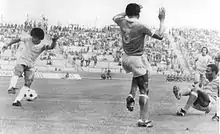
| Pos | Team | Pld | W | D | L | GF | GA | GD | Pts | Qualification |
|---|---|---|---|---|---|---|---|---|---|---|
| 1 | 3 | 1 | 2 | 0 | 10 | 1 | +9 | 4 | Advance to second round | |
| 2 | 3 | 1 | 2 | 0 | 3 | 0 | +3 | 4 | ||
| 3 | 3 | 1 | 2 | 0 | 3 | 1 | +2 | 4 | ||
| 4 | 3 | 0 | 0 | 3 | 0 | 14 | −14 | 0 |
| 13 June 1974 | |||
| Brazil | 0–0 | Waldstadion, Frankfurt | |
| 14 June 1974 | |||
| Zaire | 0–2 | Westfalenstadion, Dortmund | |
| 18 June 1974 | |||
| Scotland | 0–0 | Waldstadion, Frankfurt | |
| Yugoslavia | 9–0 | Parkstadion, Gelsenkirchen | |
| 22 June 1974 | |||
| Scotland | 1–1 | Waldstadion, Frankfurt | |
| Zaire | 0–3 | Parkstadion, Gelsenkirchen |
Group 3
| Pos | Team | Pld | W | D | L | GF | GA | GD | Pts | Qualification |
|---|---|---|---|---|---|---|---|---|---|---|
| 1 | 3 | 2 | 1 | 0 | 6 | 1 | +5 | 5 | Advance to second round | |
| 2 | 3 | 1 | 2 | 0 | 3 | 0 | +3 | 4 | ||
| 3 | 3 | 0 | 2 | 1 | 2 | 5 | −3 | 2 | ||
| 4 | 3 | 0 | 1 | 2 | 1 | 6 | −5 | 1 |
| 15 June 1974 | |||
| Uruguay | 0–2 | Niedersachsenstadion, Hanover | |
| Sweden | 0–0 | Rheinstadion, Düsseldorf | |
| 19 June 1974 | |||
| Bulgaria | 1–1 | Niedersachsenstadion, Hanover | |
| Netherlands | 0–0 | Westfalenstadion, Dortmund | |
| 23 June 1974 | |||
| Bulgaria | 1–4 | Westfalenstadion, Dortmund | |
| Sweden | 3–0 | Rheinstadion, Düsseldorf |
Group 4
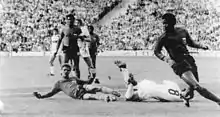
| Pos | Team | Pld | W | D | L | GF | GA | GD | Pts | Qualification |
|---|---|---|---|---|---|---|---|---|---|---|
| 1 | 3 | 3 | 0 | 0 | 12 | 3 | +9 | 6 | Advance to second round | |
| 2 | 3 | 1 | 1 | 1 | 7 | 5 | +2 | 3 | ||
| 3 | 3 | 1 | 1 | 1 | 5 | 4 | +1 | 3 | ||
| 4 | 3 | 0 | 0 | 3 | 2 | 14 | −12 | 0 |
| 15 June 1974 | |||
| Italy | 3–1 | Olympiastadion, Munich | |
| Poland | 3–2 | Neckarstadion, Stuttgart | |
| 19 June 1974 | |||
| Argentina | 1–1 | Neckarstadion, Stuttgart | |
| Haiti | 0–7 | Olympiastadion, Munich | |
| 23 June 1974 | |||
| Argentina | 4–1 | Olympiastadion, Munich | |
| Poland | 2–1 | Neckarstadion, Stuttgart |
Second round
The second round, or second group stage, saw the eight teams progressing from the first round divided into two groups of four teams on the basis of the tournament regulations. Group A would consist of the winners of Groups 1 and 3, plus the runners-up from Groups 2 and 4. Group B would consist of the other four teams, namely the winners of Groups 2 and 4, plus the runners-up from Group 1 and 3. Like the first group stage, each group in the second round was a round-robin of six games, where each team played one match against each of the other teams in the same group. Teams were awarded two points for a win, one point for a draw and none for a defeat. The two teams finishing first in each group advanced to the final, while the two runners-up would meet to decide third place.
Tie-breaking criteria
Teams were ranked on the following criteria:
- 1. Greater number of points in all second round group matches
- 2. Goal difference in all second round group matches
- 3. Goals scored in all second round group matches
- 4. Higher finishing position in the table in the first round
- 5. Drawing of lots by the FIFA Organising Committee
All times listed below are at local time (UTC+1)
Group A
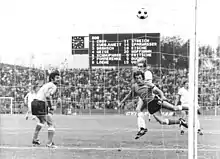
| Pos | Team | Pld | W | D | L | GF | GA | GD | Pts | Qualification |
|---|---|---|---|---|---|---|---|---|---|---|
| 1 | 3 | 3 | 0 | 0 | 8 | 0 | +8 | 6 | Advance to final | |
| 2 | 3 | 2 | 0 | 1 | 3 | 3 | 0 | 4 | Advance to third place play-off | |
| 3 | 3 | 0 | 1 | 2 | 1 | 4 | −3 | 1 | ||
| 4 | 3 | 0 | 1 | 2 | 2 | 7 | −5 | 1 |
Group B
| Pos | Team | Pld | W | D | L | GF | GA | GD | Pts | Qualification |
|---|---|---|---|---|---|---|---|---|---|---|
| 1 | 3 | 3 | 0 | 0 | 7 | 2 | +5 | 6 | Advance to final | |
| 2 | 3 | 2 | 0 | 1 | 3 | 2 | +1 | 4 | Advance to third place play-off | |
| 3 | 3 | 1 | 0 | 2 | 4 | 6 | −2 | 2 | ||
| 4 | 3 | 0 | 0 | 3 | 2 | 6 | −4 | 0 |
| 26 June 1974 | |||
| Yugoslavia | 0–2 | Rheinstadion, Düsseldorf | |
| Sweden | 0–1 | Neckarstadion, Stuttgart | |
| 30 June 1974 | |||
| Poland | 2–1 | Waldstadion, Frankfurt | |
| West Germany | 4–2 | Rheinstadion, Düsseldorf | |
| 3 July 1974 | |||
| Poland | 0–1 | Waldstadion, Frankfurt | |
| Sweden | 2–1 | Rheinstadion, Düsseldorf |
Knockout stage
The third place play-off was the first match in FIFA World Cup history in which a penalty shoot-out could potentially be held (in the event of the score being level after the regular 90 minutes and 30 minutes' extra time). If the teams remained tied in the final after extra time, a replay would be held. Only if the scores remained level during the replay after the regular 90 minutes and 30 minutes' extra time would penalties be used to determine the champion. At all previous World Cup tournaments, the drawing of lots had been foreseen in this situation to split the teams.
All times listed below are at local time (UTC+1)
Third place play-off
Final
| Netherlands | 1–2 | |
|---|---|---|
| Neeskens |
Report | Breitner Müller |
Goalscorers
With seven goals, Grzegorz Lato of Poland was the top scorer in the tournament. In total, 97 goals were scored by 53 players, with three of them credited as own goals.
7 goals
5 goals
4 goals
3 goals
2 goals
1 goal
 Rubén Ayala
Rubén Ayala Carlos Babington
Carlos Babington Miguel Ángel Brindisi
Miguel Ángel Brindisi Ramón Heredia
Ramón Heredia Valdomiro
Valdomiro.svg.png.webp) Hristo Bonev
Hristo Bonev Sergio Ahumada
Sergio Ahumada Martin Hoffmann
Martin Hoffmann Jürgen Sparwasser
Jürgen Sparwasser Pietro Anastasi
Pietro Anastasi Romeo Benetti
Romeo Benetti Fabio Capello
Fabio Capello Gianni Rivera
Gianni Rivera Theo de Jong
Theo de Jong Ruud Krol
Ruud Krol Rob Rensenbrink
Rob Rensenbrink.svg.png.webp) Jerzy Gorgoń
Jerzy Gorgoń Peter Lorimer
Peter Lorimer Conny Torstensson
Conny Torstensson Ricardo Pavoni
Ricardo Pavoni Rainer Bonhof
Rainer Bonhof Bernhard Cullmann
Bernhard Cullmann Jürgen Grabowski
Jürgen Grabowski Uli Hoeneß
Uli Hoeneß.svg.png.webp) Vladislav Bogićević
Vladislav Bogićević.svg.png.webp) Dragan Džajić
Dragan Džajić.svg.png.webp) Josip Katalinski
Josip Katalinski.svg.png.webp) Branko Oblak
Branko Oblak.svg.png.webp) Ilija Petković
Ilija Petković
Own goals
 Roberto Perfumo (for Italy)
Roberto Perfumo (for Italy).svg.png.webp) Colin Curran (for East Germany)
Colin Curran (for East Germany) Ruud Krol (for Bulgaria)
Ruud Krol (for Bulgaria)
FIFA retrospective ranking
In 1986, FIFA published a report that ranked all teams in each World Cup up to and including 1986, based on progress in the competition, overall results and quality of the opposition.[8][9] The rankings for the 1974 tournament were as follows:
| R | Team | G | P | W | D | L | GF | GA | GD | Pts. |
|---|---|---|---|---|---|---|---|---|---|---|
| 1 | 1/B | 7 | 6 | 0 | 1 | 13 | 4 | +9 | 12 | |
| 2 | 3/A | 7 | 5 | 1 | 1 | 15 | 3 | +12 | 11 | |
| 3 | 4/B | 7 | 6 | 0 | 1 | 16 | 5 | +11 | 12 | |
| 4 | 2/A | 7 | 3 | 2 | 2 | 6 | 4 | +2 | 8 | |
| Eliminated in the second group stage | ||||||||||
| 5 | 3/B | 6 | 2 | 2 | 2 | 7 | 6 | +1 | 6 | |
| 6 | 1/A | 6 | 2 | 2 | 2 | 5 | 5 | 0 | 6 | |
| 7 | 2/B | 6 | 1 | 2 | 3 | 12 | 7 | +5 | 4 | |
| 8 | 4/A | 6 | 1 | 2 | 3 | 9 | 12 | −3 | 4 | |
| Eliminated in the first group stage | ||||||||||
| 9 | 2 | 3 | 1 | 2 | 0 | 3 | 1 | +2 | 4 | |
| 10 | 4 | 3 | 1 | 1 | 1 | 5 | 4 | +1 | 3 | |
| 11 | 1 | 3 | 0 | 2 | 1 | 1 | 2 | −1 | 2 | |
| 12 | 3 | 3 | 0 | 2 | 1 | 2 | 5 | −3 | 2 | |
| 13 | 3 | 3 | 0 | 1 | 2 | 1 | 6 | −5 | 1 | |
| 14 | 1 | 3 | 0 | 1 | 2 | 0 | 5 | −5 | 1 | |
| 15 | 4 | 3 | 0 | 0 | 3 | 2 | 14 | −12 | 0 | |
| 16 | 2 | 3 | 0 | 0 | 3 | 0 | 14 | −14 | 0 | |
References
- "1974 FIFA World Cup Germany - Awards". FIFA.com. Fédération Internationale de Football Association. Retrieved 3 February 2019.
- "Das ist der Fahrplan". Kicker – Sonderheft WM '74 (in German). May–June 1974. p. 5.
- https://www.theguardian.com/football/2018/jun/21/argentina-croatia-world-cup-2018-group-d-match-report
- "1966 & 1974 World Cups Were Fixed – Former FIFA President". Goal.com. 26 June 2008. Retrieved 28 October 2011.
- "FIFA World Cup seeded teams" (PDF). FIFA World Cup seeded teams 1930–2006.
- [Ein Elfjähriger schreibt Fußball-Geschichte |url=http://www.zdf.de/ZDFde/inhalt/4/0,1872,3022116,00.html Archived 26 August 2007 at the Wayback Machine]
- (de) Karl Adolf Scherer: Die Deutschen in einer Gruppe: Die Auslosung am 5. Januar 1974 aus Fußballweltmeisterschaft 1974, page 114
- "page 45" (PDF). Retrieved 28 October 2011.
- "FIFA World Cup: Milestones, facts & figures. Statistical Kit 7" (PDF). FIFA. 26 March 2013. Archived from the original (PDF) on 21 May 2013.
